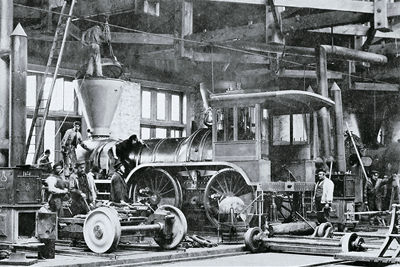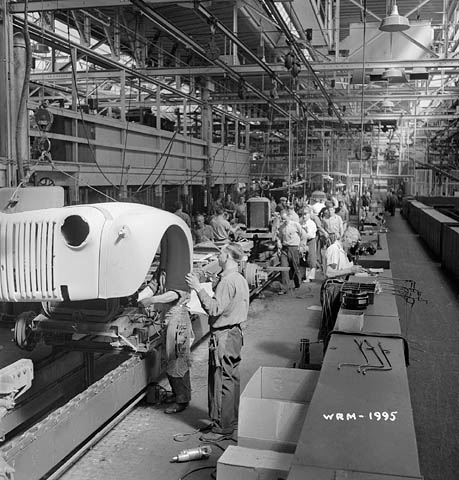Browse "Things"
-
Article
Indoor Bowling
Bowling, indoor, game in which a player attempts to knock down pins by propelling a ball down a wooden lane. Similar games were played as early as 5000 BC in Egypt. The 10-pin version was developed in the US in the 19th century, and 5-pin bowling was invented in Canada in 1908 or 1909 by Thomas F.
"https://development.thecanadianencyclopedia.ca/images/tce_placeholder.jpg?v=e9dca980c9bdb3aa11e832e7ea94f5d9" // resources/views/front/categories/view.blade.php
https://development.thecanadianencyclopedia.ca/images/tce_placeholder.jpg?v=e9dca980c9bdb3aa11e832e7ea94f5d9
-
Article
Industrial Archaeology
Industrial ARCHAEOLOGY is a type of interdisciplinary history that promotes understanding of the industrial era by focusing on physical remains, whether above ground or below, and by combining the insights of fieldwork and historical research.
"https://development.thecanadianencyclopedia.ca/images/tce_placeholder.jpg?v=e9dca980c9bdb3aa11e832e7ea94f5d9" // resources/views/front/categories/view.blade.php
https://development.thecanadianencyclopedia.ca/images/tce_placeholder.jpg?v=e9dca980c9bdb3aa11e832e7ea94f5d9
-
Article
Industrial Design
The major early developments in industrial design occurred in continental Europe, principally England, Germany and Scandinavia.
"https://d2ttikhf7xbzbs.cloudfront.net/media/media/d5e6c87c-7a50-418f-af6e-a5558582b230.jpg" // resources/views/front/categories/view.blade.php
https://d2ttikhf7xbzbs.cloudfront.net/media/media/d5e6c87c-7a50-418f-af6e-a5558582b230.jpg
-
Article
Industrial Quality Control
Industrial Quality Control uses scientific techniques to determine product and service capabilities, to enable an organization to economically provide a product or service suitable for its intended purpose.
"https://development.thecanadianencyclopedia.ca/images/tce_placeholder.jpg?v=e9dca980c9bdb3aa11e832e7ea94f5d9" // resources/views/front/categories/view.blade.php
https://development.thecanadianencyclopedia.ca/images/tce_placeholder.jpg?v=e9dca980c9bdb3aa11e832e7ea94f5d9
-
Article
Industrial Relations
The phrase "industrial relations" became widely used during WWII, for two main reasons: the major growth of the numerous war-time industries and, even more, the adoption of PC 1003 by the federal Cabinet on 17 February 1944.
"https://development.thecanadianencyclopedia.ca/images/tce_placeholder.jpg?v=e9dca980c9bdb3aa11e832e7ea94f5d9" // resources/views/front/categories/view.blade.php
https://development.thecanadianencyclopedia.ca/images/tce_placeholder.jpg?v=e9dca980c9bdb3aa11e832e7ea94f5d9
-
Article
Industrial Research and Development
Technological innovation is essential for economic growth and for the improvement of the quality of life. Industrial research and development (R & D) is at the heart of the innovative process.
"https://development.thecanadianencyclopedia.ca/images/tce_placeholder.jpg?v=e9dca980c9bdb3aa11e832e7ea94f5d9" // resources/views/front/categories/view.blade.php
https://development.thecanadianencyclopedia.ca/images/tce_placeholder.jpg?v=e9dca980c9bdb3aa11e832e7ea94f5d9
-
Article
Industrial Strategy
Industrial strategy is a term that generally refers to any attempt by government to apply a coherent and consistent set of policies that are designed to improve the performance of the ECONOMY.
"https://development.thecanadianencyclopedia.ca/images/tce_placeholder.jpg?v=e9dca980c9bdb3aa11e832e7ea94f5d9" // resources/views/front/categories/view.blade.php
https://development.thecanadianencyclopedia.ca/images/tce_placeholder.jpg?v=e9dca980c9bdb3aa11e832e7ea94f5d9
-
Article
Industrial Unionism
The first significant attempt to organize on an industrial basis was undertaken in the 1880s by the KNIGHTS OF LABOR, which advocated unity of the producing classes and opposed employer blacklists and discrimination.
"https://d2ttikhf7xbzbs.cloudfront.net/media/media/13cef129-bb89-4686-97b1-a512f5d675f1.jpg" // resources/views/front/categories/view.blade.php
https://d2ttikhf7xbzbs.cloudfront.net/media/media/13cef129-bb89-4686-97b1-a512f5d675f1.jpg
-
Article
Industrial Workers of the World
IWW propaganda was disseminated primarily in street meetings. In 1912, when Vancouver authorities tried to ban street demonstrations, the Wobblies started and won a spectacular free-speech fight.
"https://d2ttikhf7xbzbs.cloudfront.net/media/media/85c764cc-4b3c-42f9-9953-5f1f2c40cbde.jpg" // resources/views/front/categories/view.blade.php
https://d2ttikhf7xbzbs.cloudfront.net/media/media/85c764cc-4b3c-42f9-9953-5f1f2c40cbde.jpg
-
Article
Industrialization in Canada
Industrialization is a process of economic and social change. It is one that shifts the centres of economic activity onto the focus of work, wages and incomes. These changes took two forms in Canada, beginning in the 19th century. First, economic and social activities were transformed from agriculture and natural resource extraction to manufacturing and services. Second, economic and social activities shifted from rural cottage industries to urban industrial pursuits. Industrialized production took place under the privately owned factory system, in which a larger proportion of the population expected to be wage earners for all of their working lives. Therefore, industrialization brought major changes, not only in work and the economy, but in the way society was organized and in the relations among different groups in society. Although it has evolved over nearly two centuries, the process of industrialization is considered revolutionary — as the term Industrial Revolution suggests — because it marked the shift from feudalism to capitalism, and from agriculture to manufacturing and services — changes that fundamentally altered human existence. This is the full-length entry about Industrialization in Canada. For a plain-language summary, please see Industrialization in Canada (Plain-Language Summary).
"https://d2ttikhf7xbzbs.cloudfront.net/media/media/e82643fb-76c4-461d-ba67-acf2e559c83a.jpg" // resources/views/front/categories/view.blade.php
https://d2ttikhf7xbzbs.cloudfront.net/media/media/e82643fb-76c4-461d-ba67-acf2e559c83a.jpg
-
Article
Industrialization in Canada (Plain-Language Summary)
Industrialization is a process. It first occurred in Britain in the mid-1700s. That period is called the First Industrial Revolution. At that time, industries that manufactured products began to increase in number. (See also Manufacturing in Canada). The places where the products were made are called factories. Industries became more important than agriculture for the economy. This was a revolution. This had never happened before. In the past, land had always meant wealth. So, landowners were always the wealthiest people. During the Industrial Revolution, the individuals and companies that owned the factories became wealthy. Another big change was that fewer people farmed. They moved to cities to work in factories. This meant that cities became bigger and bigger. Thus, the industrial revolution led to urbanization. It also led to workers earning wages (or money) for their work. This was another first. This article is a plain-language summary of Industrialization in Canada. If you are interested in reading about this topic in more depth, please see our full-length entry, Industrialization in Canada.
"https://d2ttikhf7xbzbs.cloudfront.net/industrializationincanada/assemblyfordcompanyofcanada.jpg" // resources/views/front/categories/view.blade.php
https://d2ttikhf7xbzbs.cloudfront.net/industrializationincanada/assemblyfordcompanyofcanada.jpg
-
Article
Industry in Canada
Industry, in its broadest sense, includes all economic activity, but for convenience commentators divide it into three sectors: primary, secondary and tertiary.
"https://d2ttikhf7xbzbs.cloudfront.net/media/media/804ad87a-c2a5-4d29-814e-542e786b1778.jpg" // resources/views/front/categories/view.blade.php
https://d2ttikhf7xbzbs.cloudfront.net/media/media/804ad87a-c2a5-4d29-814e-542e786b1778.jpg
-
Article
Infantry
Known as the “Queen of Battle,” the infantry is the branch of the army that provides its primary fighters. The main responsibility of infantry soldiers is to “close with and destroy the enemy.” Although they are trained, armed and equipped to fight on foot, infantry soldiers are usually transported to the battlefield by other means. Infantry soldiers can also specialize as light, mechanized, airmobile, airborne and other types. The characteristics of infantry are mobility, firepower, flexibility, communications and vulnerability (to enemy action). Infantry soldiers are trained in a wide range of individual and crew-served weapons and work with the all-arms team of reconnaissance, armour, artillery, air defence, engineers, tactical aviation and other combat specialists. Except for a brief time during the feudal period (when cavalry dominated), the infantry has been the largest single component of armies since ancient times. In Canada, the infantry has always been the army’s largest element.
"https://d2ttikhf7xbzbs.cloudfront.net/Infantry/InfantryCorpsBadge.jpg" // resources/views/front/categories/view.blade.php
https://d2ttikhf7xbzbs.cloudfront.net/Infantry/InfantryCorpsBadge.jpg
-
Article
Inflation in Canada
Inflation popularly means rising general prices, most frequently calculated by the consumer price index (CPI) — a measure of the cost of a basket of commodities purchased by a typical family.
"https://development.thecanadianencyclopedia.ca/images/tce_placeholder.jpg?v=e9dca980c9bdb3aa11e832e7ea94f5d9" // resources/views/front/categories/view.blade.php
https://development.thecanadianencyclopedia.ca/images/tce_placeholder.jpg?v=e9dca980c9bdb3aa11e832e7ea94f5d9
-
List
Influential Indigenous Rights Court Cases in Canada
Rights of Indigenous peoples in Canada are recognized within Canada’s Constitution Act, 1982 in section 35. However, these rights are not clearly defined or explained within the Constitution Act, 1982, resulting in numerous Indigenous rights court cases. These influential court cases have helped to establish Indigenous rights within Canada and to clarify concepts surrounding Indigenous rights.
"https://development.thecanadianencyclopedia.ca/images/tce_placeholder.jpg?v=e9dca980c9bdb3aa11e832e7ea94f5d9" // resources/views/front/categories/view.blade.php
https://development.thecanadianencyclopedia.ca/images/tce_placeholder.jpg?v=e9dca980c9bdb3aa11e832e7ea94f5d9
